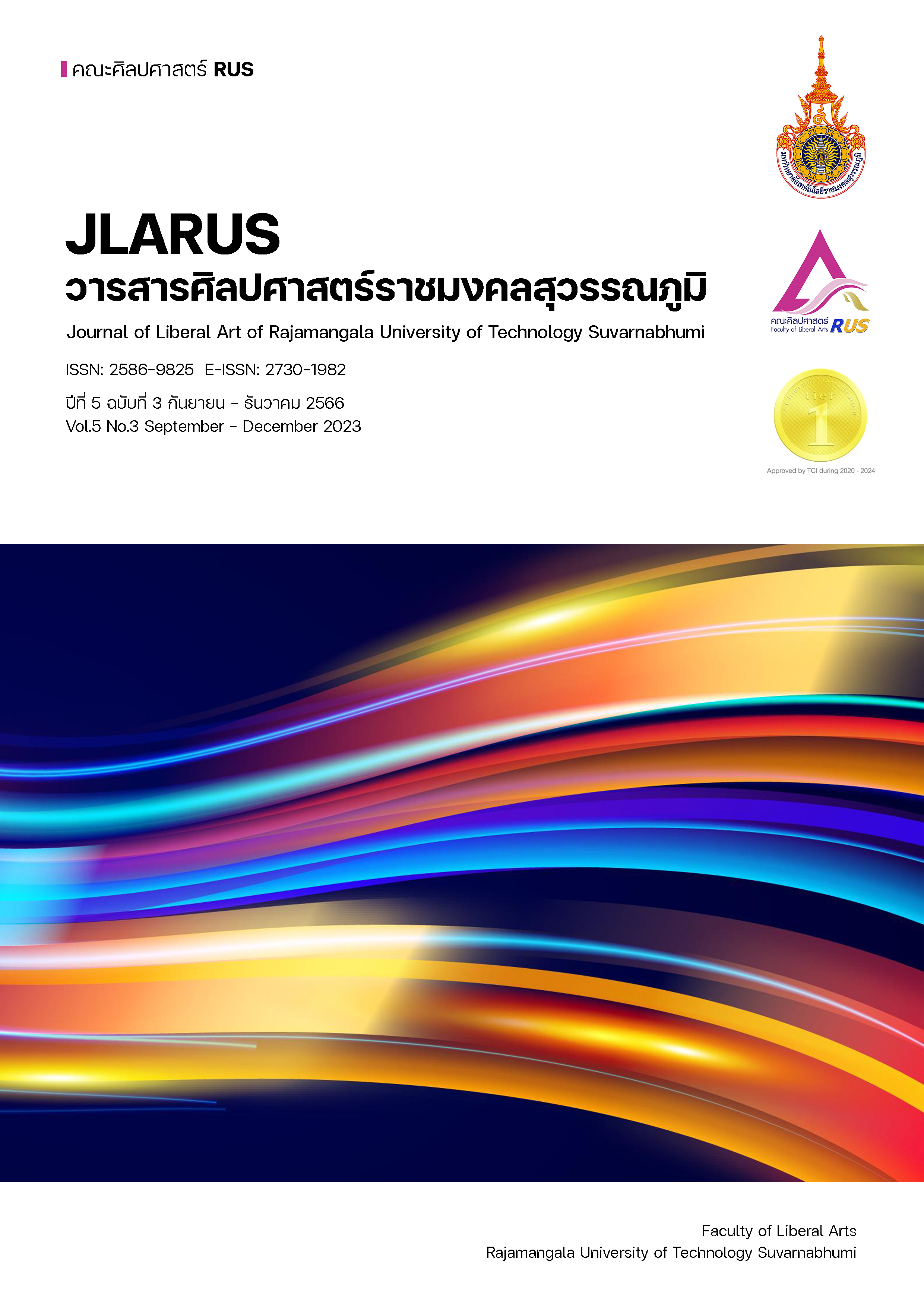AN ASSESSMENT ON GASTRONOMY TOURISM POTENTIAL OF CHIANG RAI PROVINCE BASED ON BCG ECONOMY CONCEPT
Main Article Content
Abstract
The objectives of the research on an assessment on gastronomy tourism potential of Chiang Rai Province based on BCG economy (Bio. Circular and Green Economy Concept) 1) To assess gastronomy tourism potential of Chiang Rai Province based on BCG economic concept and 2) To study the characteristics and appropriate form of gastronomy tourism of Chiang Rai Province. A qualitative research method was used using a structured In-depth Interview as a tool to collect data from a sample group consisting of representatives from tourism-related agencies. Both government and private sector, tourism and food academics and tourists by using purposive sampling method. Key results found from the study found that Chiang Rai Province has the potential to be a gastronomic tourist destination based on the BCG economic concept, with the potential of being one of the most important tourist destinations in the country and having a good location, plenty and variety of tourism resources, including nature, art, culture, traditions, ways of life, and ethnic diversity. In particular the identity, authenticity and distinctiveness of local food. Being a famous production source of food materials and ingredients for cooking food and drinks such as tea and coffee, distributed in various areas of Chiang Rai Province which can be linked into tourist routes. There are restaurants that offer authentic and unique characteristics and flavors of food. In addition, it was also found that tourism management emphasizes the participation and involvement of communities and local residents, such as community-based tourism, agricultural tourism, ecotourism, sustainable tourism is considered as characteristics and appropriate forms of gastronomy tourism based on the BCG economic concept for Chiang Rai Province.
Article Details

This work is licensed under a Creative Commons Attribution-NonCommercial-NoDerivatives 4.0 International License.
References
กระทรวงการท่องเที่ยวและกีฬา. (2566). สถิติการท่องเที่ยว. สืบค้น 27 มีนาคม 2566. จาก https:// www.mots.go.th/more_news_new.php?cid=411.
การท่องเที่ยวแห่งประเทศไทย. (2565). การท่องเที่ยวเมืองรอง. สืบค้น 27 มีนาคม 2566. จาก ttps://www.tat.or.th/th.
คณะกรรมการนโยบายการท่องเที่ยวแห่งชาติ. (2566). แผนพัฒนาการท่องเที่ยวแห่งชาติ ฉบับที่ 3. กรุงเทพมหานคร: สำนักงานคณะกรรมการนโยบายการท่องเที่ยวแห่งชาติ.
ชาย โพธิสิตา. (2564). การวิจัยเชิงคุณภาพ. (พิมพ์ครั้งที่ 9). กรุงเทพมหานคร: บริษัท อัมรินทร์พริ้นติ้ง แอนด์ พับลิชชิ่ง จำกัด (มหาชน).
ณัฎฐกานต์ พฤกษ์สรนันทน์, จุฑามาศ วิศาลสิงห์, และฐานกาญจน์ วงศ์วิศิษฎ์ศิลป์. (2561). แนวทางการสอดประสานวิถีไทยและภูมิปัญญาท้องถิ่นสู่ห่วงโซ่อาหาร เพื่อเพิ่มคุณค่าและมูลค่าการท่องเที่ยว. วารสารวิทยาการจัดการสมัยใหม่คณะวิทยาการจัดการ มหาวิทยาลัยราชภัฏลําปาง, 10(2), 169-182.
ดรรชนี เอมพันธุ์. (2549). หลักนันทนาการและการท่องเที่ยว. กรุงเทพมหานคร: คณะวนศาสตร์ มหาวิทยาลัยเกษตรศาสตร์.
ภัทรพร พันธุรี. (2558). การจัดกิจกรรมการท่องเที่ยวเชิงอาหาร โดยผ่านประสบการณ์ของนักท่องเที่ยวในประเทศไทย. JOURNAL OF SOUTHERN TECHNOLOGY, 8(2), 27-38
ราชบัณฑิตยสถาน. (2558). พจนานุกรมศัพท์ศึกษาศาสตร์ร่วมสมัย. กรุงเทพมหานคร: สำนักงานราชบัณฑิตยสถาน.
ศรีสมร คงพันธุ์. (2565). ของกิ๋นแม่อุ้ย ข้าวงาย ข้าวตอน ข้าวแลง อาหารเหนือลำ (อร่อย) ทุกมื้อ. กรุงเทพมหานคร: สำนักพิมพ์ ส.ส.ส.ส..
สถาบันอาหารไทย. (2566). Soft power อาหารไทย เดินอย่างไรให้ได้ประโยชน์. สืบค้น 27 มีนาคม 2566. จาก https://fic.nfi.or.th/hot_issue_detail.php?smid=2611.
สุปรียา ภูผาลา และจารุวรรณ แดงบุปผา. (2565). การพัฒนารูปแบบการท่องเที่ยวเชิงอาหารโดยชุมชนในประเทศไทย. วารสารวิชาการสถาบันเทคโนโลยีแห่งสุวรรณภูมิ. 8(1), 286-304.
เสงี่ยม บุญพัฒน์, ขวัญฤทัย ครองยุติ, อรวรรณ บุญพัฒน์, และญาณัท ศิริสาร. (2564). การประเมินความพึงพอใจและพฤติกรรมของนักท่องเที่ยวต่องานเทศกาลชิมชา ซากุระงาม วัฒนธรรมชนเผ่าและกาแฟดอยแม่สลอง ครั้งที่ 24 จังหวัดเชียงราย. วารสารบัณฑิตศึกษามหาวิทยาลัยราชภัฏเชียงราย, 4(3), 115-131.
เสงี่ยม บุญพัฒน์. (2564). ความรู้เบื้องต้นเกี่ยวกับการท่องเที่ยว. เชียงราย: สำนักวิชาการท่องเที่ยว มหาวิทยาลัยราชภัฏเชียงราย.
A. Balderas-Cejudo., I.Patterson and G.W.Leeson. (2019). Senior Foodies: A developing niche market in gastronomic tourism. International Journal of Gastronomy and Food Science. Retrieved October 12, 2022. from https://doi.org/10.1016/j.jdmn .2019.100152.
Amare Wondirad., Yihalem Kebete and Ying Li. (2021). Culinary tourism as a driver of regional economic development and socio-cultural revitalization: Evidence from Amhara National Regional State, Ethiopia. Journal of Destination Marketing & Management. Retrieved October 12, 2022, from https://doi.org/ 10.1016/j.jdmn.2020.100482.
Boonpat O., Boonpat S., Srithong P., Chuminthachak S., Yolthasart S., Utchaya N., and Saokham M. (2023). Creating Local Food for Health Tourism by Ban Nong O community, Mae Chan District, Chiang Rai Province. Kasetsart Journal of Social Sciences, 44(4): 1229–1238. for local endeavor. Retrieved March 24, 2023. from https://www.unesco.org/new/ fileadmin/MULTIMEDIA/HQ/CLT/pdf/Creative_cities-broucher_en.pdf.
G. Mehul Krishna Kumar. (2019). Gastronomic tourism - A way of supplementing tourism in the Andaman & Nicobar Islands. International Journal of Gastronomy and Food Science. Retrieved October 12, 2023. from https://doi.org/10.1016/j.ijgfs. 2019.100139.
Harrington, R. J., & Ottenbacher, M. C. (2010). Culinary tourism - A case study of the gastronomic capital. Journal of Culinary Science & Technology, 8(1), 14-32.
Jose Antonio Folgado-Fernandez, Ana Maria Campon-Cerro and Jose Manuel Hernandez-Mogollon (2019). Potential of olive oil tourism in promotin local quality food products: A case study of the region of Extremadura, Spain. Heliyon. Retrieved October 12, 2023. from https://doi.org/10.1016/j.heliyon.2019.e02653.
Maria Bonaventura Forleo and Graziella Benedetto. (2020). Creative Cities of Gastronomy: Towards relationship between city and countryside. International Journal of Gastronomy and Food Science. Retrieved October 12, 2023. from https:// doi.org/10.1016/j.ijgfs.2020.100247.
Marzia Ingrassia., Claudio Bellia., Chiara Giurdanella., Pietro Columba and Stefania Chironi. (2022). Digital Influencers, Food and Tourism–A New Model of Open Innovation for Businesses in the Ho.Re.Ca.Sector. Journal of Open Innovation Technology, Market, and Complexity. Retrieved October 12, 2023. from https://doi.org/ 10.3390/joitmc.8010050.
Mitchel Hall, Cl, Sharples, L., Mitchel, R., Macionis, N., Cambourne, B., (2003). Food Tourism Around the World: Development, Management and Markets. USA. Burligton: Elsevier Ltd.
National Geographic Thailand. (2566). ท่องไปในเส้นทางสายอาหารและการกินแห่งดินแดนอาเซียนผ่าน การท่องเที่ยวเชิงอาหาร. สืบค้น 9 มีนาคม 2566. จาก https://ngthai.Com /news-activity/20864/gastronomy/.
TAT Academy. (2566). จาก BCG Model สู่ BCG Tourism เติมส่วนผสมความยั่งยืนลงในการท่องเที่ยวอาหาร–ชุมชน–สุขภาพ. สืบค้น 15 มีนาคม 2566. จากhttps://www.bcg.in.th/ data-center/articles/bcg-tourism/.
UNESCO Creative Cities Network. (2016). The Creative Cities Network: a global platform
Unilever Food Solution. (2566). เทรนด์อาหารกำลังมาแรงปี 2022: อาหารเชิงท่องเที่ยว. Retrieved March 9, 2023. From https://www.unileverfoodsolutions.co.th/th/ chef-inspiration/trendwatch/trend3-gastronomy-tourism.html.
UNWTO. (2020). 11 International tourism expected to decline over 70% in 2020, back to levels of 30 years ago. Retrieved March 20, 2023. From https://www.e-unwto.org/doi/epdf/10.18111/wtobarometereng.2020.18.1.7.
Yener Ogan and Muhabbet Celik. (2023). A gastronomic product in Turkish culinary culture: A sesearch on Yozgat Canak cheese. International Journal of Gastronomy and Food Science. Retrieved March 20, 2023. From https://doi.org /10.1016/h,uhgfs.2022.100650.


